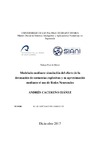Identificador persistente para citar o vincular este elemento:
https://accedacris.ulpgc.es/jspui/handle/10553/41980
| Campo DC | Valor | idioma |
|---|---|---|
| dc.contributor.advisor | Galván González, Blas José | - |
| dc.contributor.author | Cacereño Ibáñez, Andrés | - |
| dc.date.accessioned | 2018-09-20T08:05:57Z | - |
| dc.date.available | 2018-09-20T08:05:57Z | - |
| dc.date.issued | 2017 | en_US |
| dc.identifier.uri | https://accedacris.ulpgc.es/handle/10553/41980 | - |
| dc.description | Máster Universitario en Sistemas Inteligentes y Aplicaciones Numéricas en Ingeniería (MUSIANI) | en_US |
| dc.description.abstract | En España, el Real Decreto 840/2015 incide en la necesidad de analizar el riesgo ante la presencia de sustancias peligrosas en establecimientos industriales y planificar las posibles emergencias. El Real Decreto 1196/2003, establece como se calculan las consecuencias de estos accidentes. Para modelar las consecuencias, la literatura científica aporta métodos de cálculo para establecer las zonas objeto de planificación. Por otra parte, los Sistemas Inteligentes basados en el aprendizaje automático, son capaces de emular el comportamiento esperado de la ejecución de los métodos matemáticos. Este trabajo muestra como el correcto ajuste de un sistema en base a Redes Neuronales Artificiales es capaz de predecir la respuesta esperada con un margen de error que satisface las necesidades del problema. | en_US |
| dc.description.abstract | In Spain, the Real Decreto 840/2015 establishes the need to analyze the risk from hazardous substances in industrial establishments, and how to plan possible emergencies. The Real Decreto 1196/2003 establishes the way for calculating the consequences from serious accidents. To model the consequences, the scientific literature provides calculation methods that allow to establish the areas under planning. On the other hand, Inteligent Systems based on machine learning are capables to emule the expected behavior for the calculate methods. This work shows how with the correct asjustment, a inteligent system based on Artificial Neural Network can predict an expected response with a margin of error that meets the needs of the problem that arises. | en_US |
| dc.language | spa | en_US |
| dc.subject | 1203 Ciencia de los ordenadores | en_US |
| dc.subject | 3304 Tecnología de los ordenadores | en_US |
| dc.title | Modelado mediante simulación del efecto de la detonación de sustancias explosivas y su aproximación mediante el uso de redes neuronales | en_US |
| dc.type | info:eu-repo/semantics/masterThesis | en_US |
| dc.type | MasterThesis | en_US |
| dc.contributor.centro | Instituto Universitario de Sistemas Inteligentes y Aplicaciones Numéricas en Ingeniería (SIANI) | en_US |
| dc.contributor.departamento | Departamento de Matemáticas | en_US |
| dc.investigacion | Ingeniería y Arquitectura | en_US |
| dc.type2 | Trabajo final de máster | en_US |
| dc.utils.revision | Sí | en_US |
| dc.identifier.matricula | TFT-46359 | es |
| dc.identifier.ulpgc | Sí | en_US |
| dc.contributor.buulpgc | BU-INF | en_US |
| dc.contributor.titulacion | Máster Universitario en Sistemas Inteligentes y Aplicaciones Numéricas en Ingeniería | es |
| item.fulltext | Con texto completo | - |
| item.grantfulltext | open | - |
| crisitem.author.dept | GIR SIANI: Computación Evolutiva y Aplicaciones | - |
| crisitem.author.dept | IU Sistemas Inteligentes y Aplicaciones Numéricas | - |
| crisitem.author.dept | Departamento de Matemáticas | - |
| crisitem.author.orcid | 0000-0002-3947-185X | - |
| crisitem.author.parentorg | IU Sistemas Inteligentes y Aplicaciones Numéricas | - |
| crisitem.author.fullName | Cacereño Ibáñez, Andrés | - |
| crisitem.advisor.dept | GIR SIANI: Computación Evolutiva y Aplicaciones | - |
| crisitem.advisor.dept | IU Sistemas Inteligentes y Aplicaciones Numéricas | - |
| Colección: | Trabajo final de máster | |
Visitas
176
actualizado el 01-nov-2024
Descargas
181
actualizado el 01-nov-2024
Google ScholarTM
Verifica
Comparte
Exporta metadatos
Los elementos en ULPGC accedaCRIS están protegidos por derechos de autor con todos los derechos reservados, a menos que se indique lo contrario.
